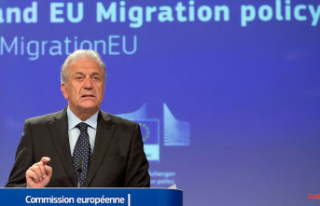For months, President Zelenskiy has sometimes demanded, sometimes courted, even begged - for more anti-aircraft weapons for Ukraine. Now the USA has promised a battery for its Patriot system. Can that help decisively in the fight against Russia?
What can the Patriot system do?
Patriot is an air defense system that fires the missile from a mobile launch pad called the launcher. It fights aircraft, but also cruise missiles - which fly with their own propulsion and can steer themselves to the target. Because cruise missiles can fly very low, they are difficult to locate by enemy radar.
The Patriot system's radar is significantly superior to that of the Soviet S-300, which is the main use of the Ukrainian air defenses. It therefore has a better chance of repelling an attacking cruise missile. But the Patriot makes a real difference when combined with other weapons, such as satellites and drones, which can detect an enemy missile as it is fired, long before it appears on the Patriot radar.
"If, for example, the satellite or a drone reports that a missile has been launched from Belarus or the Black Sea, the Patriot system in Ukraine has enough time to align the defense missiles," says Austrian officer and military expert Markus Reisner ntv .de. The launch can then take place based on its own radar system. But Patriots are also used against short-range ballistic missiles. These do not have their own propulsion, but use the energy of the starting drive to fly in an arc to the target. This makes them easier to spot for enemy radar.
According to the Bundeswehr, the Patriot system it uses is able to control up to 50 targets at the same time, i.e. to verify flying objects and to rate them as friend or foe. It can attack five targets at the same time. The combat range varies depending on the version of the system. The Bundeswehr specifies a range of 68 kilometers for the type it uses.
The system is widespread: According to the US think tank Center for Strategic and International Studies (CSIS), 18 nations use Patriot in their air defenses, including Germany, the Netherlands and Spain, for example. Poland and Slovakia received Patriots from NATO partners in the spring to protect themselves against possible Russian attacks and to be able to deliver their own S-300 systems to Ukraine.
What specific benefits does Patriot bring to Ukraine?
"There's a lot of symbolism here," says CSIS expert Mark Cancian in US media - a lot of symbolism. The Patriot can represent that the West takes Zelenskyy's plea seriously, appreciates the record pace at which Kiev's troops are adapting to new weapons systems, and that he wants to continue to stand by Ukraine's side in the future. This symbolic power works not only outwards, but also into the USA, addressed to the Republican voices in particular, who question further aid for Ukraine.
Aside from the symbolic value, the Patriot also helps militarily. However, the one battery that is being delivered to Ukraine is not going to be a game-changer in this war. "A battery has up to six launchers that can fire ammunition at the same time. A total of up to 24 shots can be fired at the same time, after which it has to be reloaded," explains Reisner. "For an attack by several cruise missiles and drones, this means that the Patriot can only fend off a limited number, all others hit their targets."
The Patriot system has been in military use for 40 years. In terms of modernity, it is inferior to systems like the German IRIS-T SLM, which Ukraine has already received. The advantage of its advanced age, however, is that the system has already been used many times: as early as the 1990s in "Operation Desert Storm" against Iraq, then in a number of conflicts and also several times by the Israeli military.
What has been tried and tested in practice and continually improved has developed into a reliable, robust system. CSIS experts therefore call the Patriot the "workhorse" of the US Army. The Bundeswehr has also had good experiences: "The deployment of our Patriot squadrons, for example in Slovakia as part of 'enhanced vigilance activities' (eVA), has shown that we can quickly bring our anti-aircraft missile defense capability to an operational area and there immediately are ready for use and effective," says a spokesman for the Air Force ntv.de.
Where is the Patriot used?
It is not yet known what kind of attacks the system is supposed to ward off in Ukraine. Military expert Gustav Gressel does not expect the Patriot to be used to counter drones. "She can't play to her strengths there," he says ntv.de. Neither the range nor the maneuverability come into play in high, thin layers of the atmosphere. "On the other hand, the Patriot shows its strengths against ballistic missiles such as Iskander or Fateh-110," says Gressel.
In addition, the Russian army often flies attacks in which a swarm of drones first takes over the Ukrainian air defenses. Subsequent cruise missiles can then reach their target unhindered. Here the Patriot could relieve the existing Ukrainian defense systems and concentrate on the cruise missiles.
A Patriot missile costs millions of dollars. Using it against drones that are only worth $20,000 each would create a mismatch. But according to Gressel, the choice of defense must be seen in relation to the potential damage. "If you protect a transformer from the drones, which is not only expensive but would also require a waiting period of more than a year to be replaced, in addition to the economic damage if there is no electricity for a year, then the costs are put into perspective ."
From Colonel Reisner's point of view, a deployment to defend against attacks on the Ukrainian capital would be likely. "As the 'center of gravity', i.e. the military and civilian center of the country, it would make sense to protect Kyiv particularly well."












